Cubism and Futurism
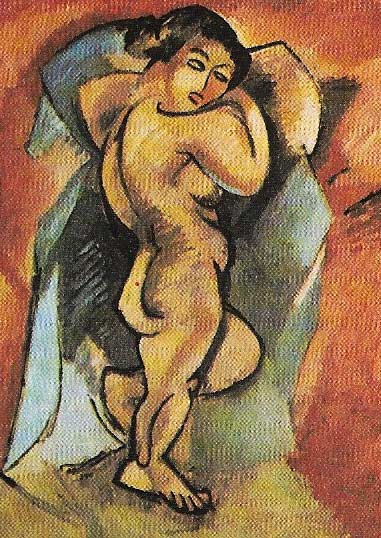
Figure 1. The distortion in George's Braque's "Large Nude" (1908) is almost fully Cubist. The buttock is presented both in profile and from behind, the left side of the back is pulled forward, and the head is swung round to look out of the picture. Moreover, the figure is made even more fully Cubist by being treated in shallow relief, its surfaces defined with an angled brushstroke precisely like the surfaces of its equally flattened setting. One of the most important influences on Braque was Paul Cezanne, from whom this "hatched" brushstroke was borrowed.
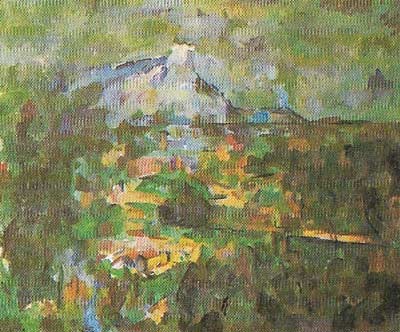
Figure 2. Paul Cezanne (1839–1906) often painted the subject of this 1904–1906 oil painting, "Mont Sainte-Victoire". He wanted to show how the volume and space was revealed by the fall of light and surfaces - warm colors where the sun struck, cool where it did not. This led him to break his paintings down into small dabs of colour, creating an effect that is both atmospherically spacious and flat. The Cubists, adopting this technique, also broke their surfaces down into small flat areas like the facets of a jewel.
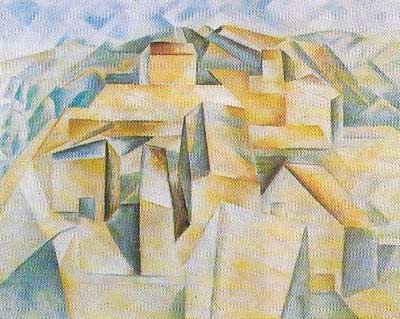
Figure 3. Pablo Picasso (1881–1973) was on holiday in the Spanish Pyrenees when he painted this oil, "Landscape, Horta de San Juan" in 1909. Reversed perspectives flatten the roofs, while the sky is effectively solidified. Braque made similar although cooler landscapes in 1908–1909. It was these landscapes and the still lifes influenced by Cezanne that prompted the critic Louis Vauxcelles to compare the work to "little cubes" which later became "cubism". However this work does not represent a fully developed version of Cubism in that it still uses traditional forms of pictorial space to denote three dimensions, albeit in distorted form.
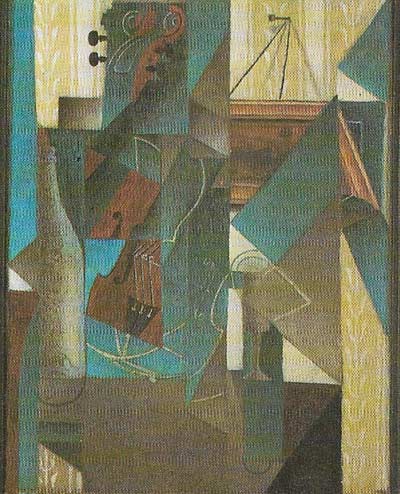
Figure 4. Juan Gris (1887–1927) achieves a perfect balance between composition and subject in his 1913 collage "Violin and Engraving". He presents the objects aspect by aspect. These fragmentary aspects together form an idea of the objects which is complete. The still life is actually more fully represented then in traditional illusionist painting, yet each fragmentary aspect is firmly contained within a stable composition of vertical strips. Gris thus creates an artificial structure on a flat surface to make another structure in three dimensions – the still life. The tiny framed engraving is in fact a real engraving stuck on, and so important was Gris's subject to him that he even suggested that a future owner might change the engraving as if it were the decor of a real room.
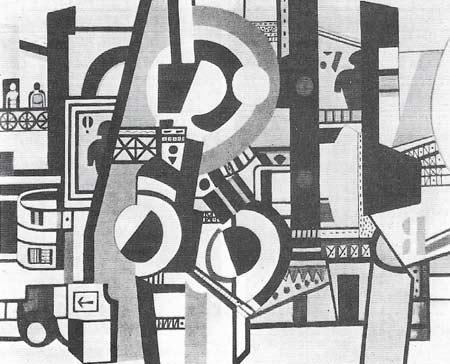
Figure 5. Leger, in his painting "Discs in the City" (1919–1920), focuses on a combination of flat disks, which appear mechanically geared together, suggesting the potential for movement. On either side there are scattered images from the city - robot men, crane derricks – which create the idea of an urban setting for the energy released by the colors and the whirl of the disks. The use of recognizable fragments to build a subject is Cubist; the subject and its dynamic interpretation have Futuristic overtones.
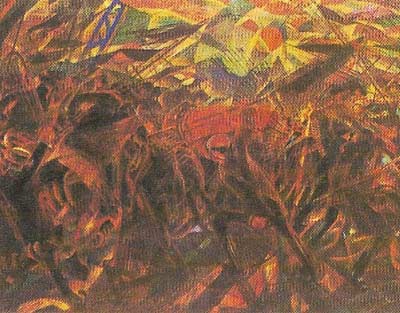
Figure 6. Carlo Carra (1881–1966) in his oil "Funeral of the Anarchist Galli" (1911–1912) combined riot and a funeral. The use of repeated images to represent the beating arms and legs is typical of Futurist painting at this time and generates a feeling of both psychological unity and violence.
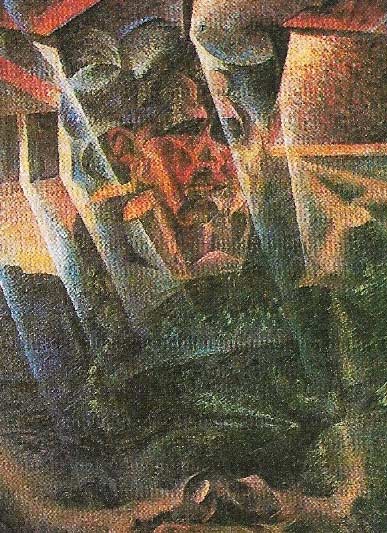
Figure 7. To the Futurists even an immobile figure could seem dynamic because of its unrelenting psychological mobility and potential for movement. Thus Boccioni painted his mother in a still pose in "Matter 1912" (detail, shown here).
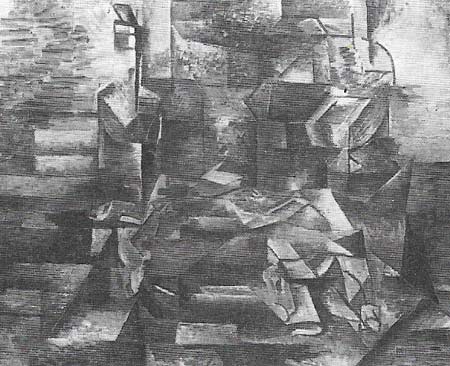
Figure 8. In Georges Braque's "Still Life with Fish" (1910) things are so fragmented and so absorbed into the overall linear scaffold that the painting is almost abstract art. The recognizable bottle and fish heads allow one to "read" the still life and also to see how much of the scaffold is the result of the distortion of observed things.
Cubism was a term of abuse invented without understanding by a disgruntled critic, Louis Vauxcelles. It came to mean an international movement whose influence is still felt not just in painting but in sculpture and architecture. Pablo Picasso made it possible. He wanted to shock, a desire rooted in the philosophy of Friedrich Nietzsche (1844–1900) and in the demand for an individualistic assault on all conventions. Georges Braque (1882–1963) met him in 1907 and was indeed at first shocked by his work, but later responded positively with an ambitious painting "The Large Nude" (1908) (Figure 1).
The basic features of Cubism are present in this painting. First, the nude is distorted by fusing into a single image more than a single view of its parts. Second, it is treated as an arrangement of forms shallowly modeled in relief and not as a fully three-dimensional figure. Both these features followed from the shared conviction that painting should not imitate the appearance of things at any one moment (as in Impressionism) but should present the artist's accumulated idea of his subject, and that painting should be itself an art of flattened forms, not of three-dimensional illusions.
Between 1908 and 1911 a further feature was added to Cubist painting. Space was solidified, making the picture a single arrangement of flattened surfaces. Braque was the first to move in this direction, inspired by Paul Cezanne's attempt to treat the world as a mosaic of flat color patches (Figure 2), and it was only in 1909, when Picasso also looked back to Cezanne that he followed Braque's lead with a series of landscapes whose skies appear as a crystalline structure almost attached to the buildings below them (Figure 3).
The invention of collage
The process of fragmentation followed by Picasso and Braque took them to the very edge of abstract art, but they always left recognizable details in their paintings because for them the real point was to create a flexible give-and-take between the spectator's appreciation of structure for its own sake and his remembered knowledge of the structure of figures and objects in nature. The invention of collage (material stuck on the canvas) in 1912 made possible both a flatter effect and a clearer reference to the objects of the subject. Although it was first developed by Picasso and Braque, the painter who most clearly used collage to create a conflict between objects and pictorial structure was Juan Gris, the closest of their early allies (Figure 4).
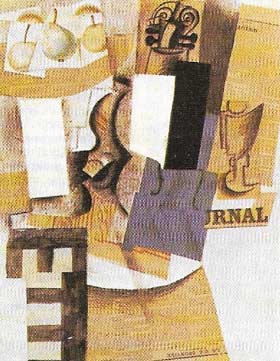 |
| Picasso's collages, such as the 1913 "Violin", are less tidy than those of Gris. He collected junk and enjoyed the idea of making something out of otherwise worthless items. Here he peruses a series of paradoxes. The cutout color prints of fruit (very realistic) sit on a piece of newspaper cut unrealistically to the rough shape of a bowl. The solid violin head tops an utterly insubstantial body. |
Principal painters of Cubism
It was Picasso, Braque, and Gris who developed the central line of Cubism, taking it further after 1918, but each in an increasingly personal way. For them Cubism was never a style with a single "look"; its basic principles lay behind innumerable variations. These Cubists remained unconcerned with communication to a wide public even when their work began to sell during the 1920s, but from as early as 1909 Cubism was taken over by artists actively concerned with communication, who often took their themes from the most popular aspects of emerging industrial society. In Paris there were the painters Jean Metzinger (1883–1956) and Albert Gleizes (1881–1953), the Duchamp brothers, the husband and wife painters Robert (1885–1941), and Sonia Delaunay (1885–1979), who tried to fuse an interest in color with a Cubist sense of structure, and most impressive of all, the Norman painter Fernand Leger (1881–1955). It was Leger who successfully experimented with the flat cut-out color planes of Cubist "collage" and the tangible modeling of early Cubist painting, adapting them to the task of communicating the sheer force of city life (Figure 5).
Outside Paris, Cubism initiated a spate of avant-garde movements: Vorticism in London, Russian and Czech Cubism, but most important of all, and an influence in modern art often the equal of Cubism itself, the Italian movement, Futurism.
The development of Futurism
Futurism was invented by the poet Filippo Tommaso Marinetti (1876–1944) who saw life as constant change and individuals as part of a dynamic system of forces caught up in progress. Modern experience heightened this vision – change was so dramatic, the machine capable of such speed. Umberto Boccioni, Carlo Carra, Luigi Russolo, Giacomo Balla (1871–1958), and Gino Severini (1883–1966), the painters whom he sponsored, concentrated on the expression of speed and change, as manifested in modern events and urban scenes (Figure 6). In 1911–1912, Cubist distortion and the breakdown of the barriers between solid and space were taken over by the Futurists, so that it is by basically Cubist means that Boccioni binds figures and setting together in his "Matter 1912" (Figure 7). Yet there can be no doubt of the originality of much Futurist art, especially that of Boccioni, evident in his bronze monument to mechanized man.
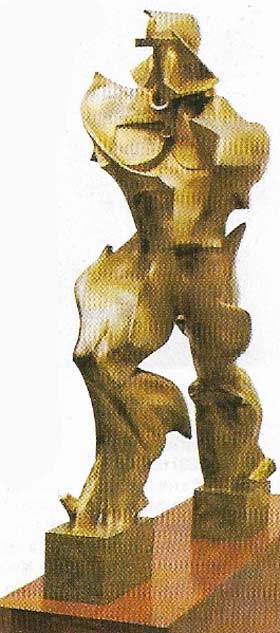 |
| Umberto Boccioni (1882–1916) in his 1913 bronze "Unique Forms of Continuity in Space" mechanized the human form, developing the prophecy of Marinetti of a mechanized human type. Boccioni's aim was to define and freeze the forms that are most expressive of the continuity of motion through space of a striding man. |
Futurism used Cubist ideas for its own ends. Its success in doing so underlines what was the major legacy of Cubism, the freedom to create the objects and scenes of the world in a fresh way. Cubism was not a style but a movement that made many styles possible because it allowed artists to paint ideas as well as what they saw. So infinitely adaptable has it been that it has led to developments as widely divergent as the geometric art of Mondrian and De Stijl and the so-called "pop art' of Robert Rauschenberg.
 FFFFig
FFFFig